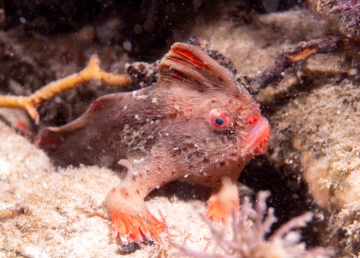740224_Helping Hands_360 px width.jpg

The red handfish is a critically endangered species, found only around Tasmania. Credit: John Turnbull, CC BY-NC-SA 2.0
Scientists in Australia are trying to paint the sea floor red. They’re giving a helping hand to the red handfish—one of the most endangered fish on the planet.
The fish is only three or four inches long. It’s named for the fins on its sides, which are shaped like small hands. In fact, the fish uses those fins to walk along the ocean floor—it seldom swims. The hands can be pinkish brown, but they can also be bright red, along with the mouth and other body parts.
Red handfish used to be common around Tasmania, a large island off the southeastern coast of Australia. Today, the population is down to about 100 adults. They’re found in two small patches that are no bigger than football fields.
In part, the population has dwindled because of an explosion in the number of sea urchins. Fishers have caught a lot of rock lobsters, which eat the urchins. Without the lobsters, the urchins have gobbled the kelp that forms an important part of the handfish habitat.
Scientists are trying to rebuild the handfish population. In 2021 and ’23, they hatched eggs in the lab, then released the youngsters into the wild. And in late 2023, they gathered 25 adults from the ocean and housed them in tanks. That was to protect them from a “marine heatwave” that could have killed off some of the fish. They, too, were scheduled to be returned to their ocean homes.
These efforts could help the red handfish survive—adding some splashes of color off the coast of Tasmania.

